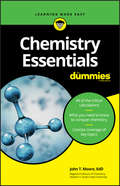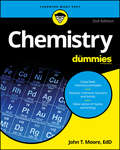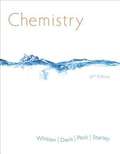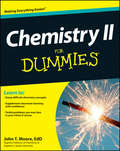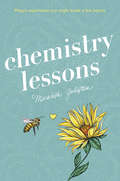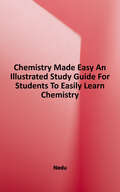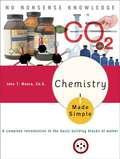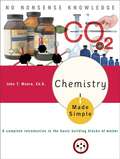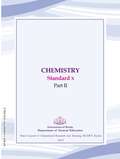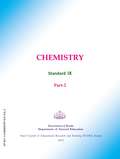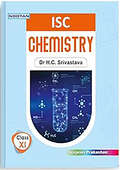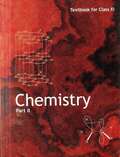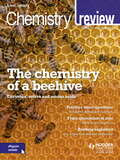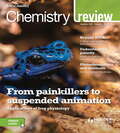- Table View
- List View
Chemistry Essentials
by Editors of REA Adrian DingleREA's Essentials provide quick and easy access to critical information in a variety of different fields, ranging from the most basic to the most advanced. As its name implies, these concise, comprehensive study guides summarize the essentials of the field covered. Essentials are helpful when preparing for exams, doing homework and will remain a lasting reference source for students, teachers, and professionals. Chemistry includes stoichiometry, atomic structure and the periodic table, bonding, chemical formulas, chemical reactions, gases, liquids, solids, phase changes, solutions, acids and bases, chemical equilibrium, acid-base equilibrium in aqueous solutions, chemical thermodynamics, and oxidation and reduction.
Chemistry Essentials For Dummies
by John T. MooreChemistry Essentials For Dummies (9781119591146) was previously published as Chemistry Essentials For Dummies (9780470618363). While this version features a new Dummies cover and design, the content is the same as the prior release and should not be considered a new or updated product. Whether studying chemistry as part of a degree requirement or as part of a core curriculum, students will find Chemistry Essentials For Dummies to be an invaluable quick reference guide to the fundamentals of this often challenging course. Chemistry Essentials For Dummies contains content focused on key topics only, with discrete explanations of critical concepts taught in a typical two-semester high school chemistry class or a college level Chemistry I course, from bonds and reactions to acids, bases, and the mole. This guide is also a perfect reference for parents who need to review critical chemistry concepts as they help high school students with homework assignments, as well as for adult learners headed back into the classroom who just need to a refresher of the core concepts. The Essentials For Dummies SeriesDummies is proud to present our new series, The Essentials For Dummies. Now students who are prepping for exams, preparing to study new material, or who just need a refresher can have a concise, easy-to-understand review guide that covers an entire course by concentrating solely on the most important concepts. From algebra and chemistry to grammar and Spanish, our expert authors focus on the skills students most need to succeed in a subject.
Chemistry For Competitive Examination-1 First Semester FYBA, B.COM, B.SC New NEP Syllabus - SPPU
by Prof. Dr. G. S. Gugale Prof. Dr. R. P. Patil Dr Y. R. Baste Dr C. N. Potangale"Chemistry for Competitive Examination-1" is a comprehensive textbook for First Year B.A., B.Com., and B.Sc. students, following the 2024 NEP syllabus. Authored by Prof. (Dr.) G. S. Gugale, Dr. Y. R. Baste, Prof. (Dr.) R. P. Patil, and Dr. C. N. Potangale, the book covers fundamental concepts in Physical, Inorganic, and Organic Chemistry, along with miscellaneous topics essential for competitive exams. Key areas include atomic structure, chemical bonding, periodic table, hydrocarbons, polymers, explosives, and drug chemistry. The book provides detailed explanations, examples, and exercises to help students build a strong foundation in chemistry for both academic and competitive examinations.
Chemistry For Dummies
by John T. MooreSee how chemistry works in everything from soaps to medicines to petroleumWe're all natural born chemists. Every time we cook, clean, take a shower, drive a car, use a solvent (such as nail polish remover), or perform any of the countless everyday activities that involve complex chemical reactions we're doing chemistry! So why do so many of us desperately resist learning chemistry when we're young?Now there's a fun, easy way to learn basic chemistry. Whether you're studying chemistry in school and you're looking for a little help making sense of what's being taught in class, or you're just into learning new things, Chemistry For Dummies gets you rolling with all the basics of matter and energy, atoms and molecules, acids and bases, and much more!Tracks a typical chemistry course, giving you step-by-step lessons you can easily graspPacked with basic chemistry principles and time-saving tips from chemistry professorsReal-world examples provide everyday context for complicated topicsFull of modern, relevant examples and updated to mirror current teaching methods and classroom protocols, Chemistry For Dummies puts you on the fast-track to mastering the basics of chemistry.
Chemistry Fourth Edition
by Elizabeth A. Lacy Rachel SantopletroChemistry, 4th ed., gives students the tools to build an understanding of atomic structure, chemical composition, and chemical reactions. Throughout the course, students will put these tools to work in different fields of chemistry in ways that can show them the impact that chemistry can have to help people and to wisely use God's world to glorify Him. This new edition features new content about semiconductors and nuclear chemistry as well as additional biblical worldview-shaping sections that help students to think through common debates among scientists.
Chemistry Funky Science (Funky Science)
by Kirsten HallSmart and savvy girls will love discovering the secrets of science! Funky Science: Chemistry has loads of cool, creative experiments presented in a fun and accessible way, relating to topics that girls love. It's a science spa as you discover what puts the fizz in bath bombs, extract essential oils to create perfect perfumes, test which homemade lip balm works best, and learn what gives exfoliation its X factor. All experiments are developed with science teachers and provide the science behind the activity along with parental guidance symbols and glossaries of Wonder Words.
Chemistry Hybrid 10th Edition
by Raymond E. Davis M. Larry Peck George G. Stanley Kenneth W. WhittonHigh School chemistry textbook.
Chemistry II For Dummies
by John T. MooreThe tools you need to ace your Chemisty II course College success for virtually all science, computing, engineering, and premedical majors depends in part on passing chemistry. The skills learned in chemistry courses are applicable to a number of fields, and chemistry courses are essential to students who are studying to become nurses, doctors, pharmacists, clinical technicians, engineers, and many more among the fastest-growing professions. But if you're like a lot of students who are confused by chemistry, it can seem like a daunting task to tackle the subject. That's where Chemistry II For Dummies can help! Here, you'll get plain-English, easy-to-understand explanations of everything you'll encounter in your Chemistry II class. Whether chemistry is your chosen area of study, a degree requirement, or an elective, you'll get the skills and confidence to score high and enhance your understanding of this often-intimidating subject. So what are you waiting for? Presents straightforward information on complex concepts Tracks to a typical Chemistry II course Serves as an excellent supplement to classroom learning Helps you understand difficult subject matter with confidence and ease Packed with approachable information and plenty of practice opportunities, Chemistry II For Dummies is just what you need to make the grade.
Chemistry In Focus: A Molecular View Of Our World
by Nivaldo J. TroThis updated and enhanced Seventh Edition of CHEMISTRY IN FOCUS helps students develop an appreciation for the molecular world that underlies the world we can see. From the first page to the last, Professor Tro emphasizes the connection between the atoms and molecules that compose matter and the properties of that matter. Students learn to see the world through the lens of chemistry and to find excitement and awe in the myriad of chemical processes occurring all around them all the time. This easy-to-understand text also helps students understand the major scientific, technological and environmental issues affecting our society. Innovative study aids such as Self-Check Questions, OWLv2 Adaptive Study Plans and new online “Big Picture” videos featuring the author help students maximize their success in the course.
Chemistry Lab Manual
by Bob Jones University Press Staff Christopher D. CoyleA chemistry laboratory is anything but boring. Laboratories are places where exciting discoveries are made, old ideas are challenged, and new ideas are formed. But a laboratory can't do any of those exciting things on its own. It needs a chemist.
Chemistry Lab Manual SBVC Chem 104 105
by Spencer L. Seager Michael R. SlabaughChemistry Lab Manual: SBVC Chem 104/105
Chemistry Lessons
by Meredith GoldsteinFrom advice columnist Meredith Goldstein, a dazzling, romantic, and emotionally resonant YA debut about a teen science whiz in Cambridge, Massachusetts, who tries to crack the chemical equation for lasting love and instead wreaks havoc on herself and the boys in her life. For seventeen-year-old Maya, the equation for happiness is simple: a dream internship at MIT + two new science nerd friends + a perfect boyfriend = one amazing summer. Then Whit dumps her out of the blue. Maya is miserable until she discovers that her scientist mother, before she died, was conducting research on manipulating pheromones to enhance human attraction. If Maya can finish her mother’s work, maybe she can get Whit back. But when her experiment creates chaos in her love life, she realizes that maybe love and loss can’t be understood using the scientific method. Can she learn to trust the unmeasurables of love and attraction instead?
Chemistry Made Easy
by NeduWhile Chemistry is a huge topic, it's not necessary to spend years studying it unless it's your major in college. For most of us, we need a clear grasp of the subject to progress through school. This book has you covered. You will surely not be a chemistry newbie after reading this. You will learn that chemistry is about matter. You can break matter down a great deal-all the way down to molecules, atoms, and subatomic particles. The smaller the matter, the more fascinating it gets.
Chemistry Made Simple, Revised Edition
by John T. MooreChemistry Made Simple was written to give you a basic understanding of chemistry, whether you are a student taking your first chemistry course or simply someone wanting to learn a bit more about the chemical world around you. The book is divided into 26 chapters, each covering a specific aspect of chemistry.
Chemistry Made Simple: A Complete Introduction to the Basic Building Blocks of Matter (Made Simple)
by John T. Moore Ed.D.See the world, one molecule at a time. Chemistry helps us understand not only the world around us, but also our own bodies. CHEMISTRY MADE SIMPLE makes it fun. Each chapter has practice problems with complete solutions that reinforce learning. A glossary of chemical terms, the modern periodic table, and detailed illustrations throughout make this the best introduction to one of the most studied of all sciences.Topics covered include: *the Scientific Method *the structure and properties of matter*compounds *laws of chemistry*gases, liquids, and solids *solutions *electrochemistry*the atmosphere*biochemistry*organic chemistry *nuclear chemistry*energy *the environment Look for these Made Simple titlesAccounting Made SimpleArithmetic Made SimpleAstronomy Made SimpleBiology Made SimpleBookkeeping Made SimpleBusiness Letters Made SimpleEarth Science Made SimpleEnglish Made SimpleFrench Made SimpleGerman Made SimpleIngles Hecho Facil Investing Made SimpleItalian Made SimpleLatin Made SimpleLearning English Made SimpleMathematics Made SimpleThe Perfect Business Plan Made SimplePhilosophy Made SimplePhysics Made SimplePsychology Made SimpleSign Language Made SimpleSpelling Made SimpleStatistics Made SimpleYour Small Business Made Simplewww.broadwaybooks.com
Chemistry Part 1 class 10 - S.C.E.R.T. - Kerala Board
by State Council of Educational Research TrainingChemistry Part 1 textbook for 10th standard from State Council of Educational Research and Training (S.C.E.R.T.) Kerala in English.
Chemistry Part 1 class 11 - NCERT
by National Council of Educational Research and Trainingchemistry Part-I textbook for the 11th standard from National Council of Educational Research and Training, New Delhi in English.
Chemistry Part 1 class 9 - S.C.E.R.T. - Kerala Board
by State Council of Educational Research TrainingChemistry Part 1 text book for 9th standard from State Council of Educational Research and Training (S.C.E.R.T.) Kerala in English.
Chemistry Part 2 class 10 - S.C.E.R.T. - Kerala Board
by State Council of Educational Research TrainingChemistry Part 2 textbook for 10th standard from State Council of Educational Research and Training (S.C.E.R.T.) Kerala in English.
Chemistry Part 2 class 9 - S.C.E.R.T. - Kerala Board
by State Council of Educational Research TrainingChemistry (Part-2) text book for 9th standard from State Council of Educational Research and Training (S.C.E.R.T.) Kerala in English.
Chemistry Part-2 class 11 - ISC
by Dr H. C. SrivastavaComputer Fundamentals: Nootan ISC Chemistry for Class XI has been thoroughly revised and restructured in the light of the latest syllabus and the detailed scope of the syllabus issued by the Council for Indian School Certificate Examination, New Delhi. Si
Chemistry Part-2 class 11 - NCERT - 23
by National Council of Educational Research and TrainingIn "Chemistry Part 2" for class 11, Unit 7 delves into Redox Reactions, presenting classical oxidation-reduction concepts and electron transfer dynamics. The unit also introduces oxidation numbers and their link to electrode processes. Transitioning to Organic Chemistry in Unit 8, readers explore the unique tetravalence of carbon, varied organic compound structures, and their classification. The unit demystifies organic compound nomenclature, introduces isomerism, and delves into organic reaction mechanisms. Techniques for purifying and analyzing organic compounds are discussed, encompassing both qualitative and quantitative approaches. Unit 9, centered on Hydrocarbons, classifies them as alkanes, alkenes, alkynes, and aromatic types, concluding with a note on certain hydrocarbons' carcinogenicity and toxicity.
Chemistry Review Magazine Volume 28, 2018/19 Issue 1
by Philip Allan MagazinesThis A-level chemistry magazine provides up-to-date articles specially written for students to help them gain the highest grade. Articles feature real-world applications of chemistry and signpost how these link with the exam. Chemistry Review also contains specific features on practical skills and on approaching exam questions.ContentsBreath of life Animal chemistry: Bees, honey and venom Drugs and dyes Did you know? Photoswitching isomers In pictures: Elements of smartphones Answer back: Polymers and azo dyes Revision note: The continuum of bonding Worth reading: The Disappearing Spoon Focus on industry: Extracting oil and gas Wonders of chemistry: Solar power: nature does it better Back page: Conservation and cyclododecane
Chemistry Review Magazine Volume 28, 2018/19 Issue 2
by Philip Allan MagazinesContentsHow clean is our air?Revision note: Disentangling polarityAnimal chemistry: Frogs and toadsIn pictures: Flying over firesWhat's your poison?Chemistry in medicine: Photochemistry and drug synthesisFocus on industry: What happens in an oil refinery?How science works: Investigating the structure of nucleic acidsSpectroscopy of space

